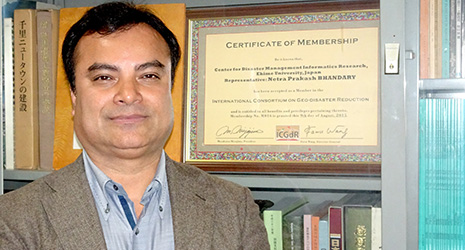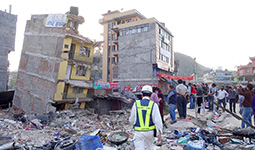Home > Highlighting JAPAN > Highlighting Japan January 2017 > Home Away from Home
Highlighting JAPAN


Knowing the Disaster Risks
Netra Prakash Bhandary has been researching disaster risks in Japan for almost twenty years while transferring local knowledge and expertise to the land of his birth, Nepal.
Nearly 70% of the land in Japan is mountainous, and consequently the country often experiences mudslides, landslides, slope failures and other sediment disasters following heavy rains and earthquakes. Many different measures, both structural and non-structural, are taken with the aim of reducing such disaster risks. Examples include the construction of mud-control dams and grating crib works using concrete to harden slopes, the creation of hazard maps, and development of alarm systems.
At Japanese universities, many researchers are tackling the development of sediment disaster risk reduction technologies. Among them is Netra Prakash Bhandary from Nepal, an associate professor of civil engineering in the Graduate School of Science and Engineering at Ehime University.
Torrential rain in 1993 caused a severe sediment disaster in Nepal that killed more than 1,300 people and affected more than 40,000 households. At that time, Bhandary was still a student at a university in India. With a strong desire to continue to graduate research, he joined a newly established engineering college in Nepal as a faculty member and worked for about three years. Then, in 1997 he happened to know Ryuichi Yatabe, a professor from Ehime University who had been sent to Nepal as a landslide expert by the Japan International Cooperation Agency (JICA) to undertake research on the 1993 disaster. This led Bhandary to visit Japan in 1997 and begin studying geotechnical engineering in the Faculty of Engineering of Ehime University.
“Shikoku island, where Ehime Prefecture is located, suffers from many landslides. While studying the geology of the region, I noticed its similarities with the terrain and geology of the mountainous areas in Nepal,” Bhandary explains. “In fact, we researched a certain area in Nepal and found that the area experienced many landslides that were similar in nature to those in Shikoku.”
Based on the results of the research, Yatabe, Bhandary and other members of the research team from Ehime University commenced research in 2000 on issues such as the geology and clay mineralogy of landslide areas in the mountains of mid-Nepal and the earthquake disaster risk in the Kathmandu basin where the capital is located. The research has continued for more than a decade, followed by the publication of more than 100 academic papers on natural disasters in Nepal and eighteen international symposiums held so far in Kathmandu.
Amid these activities, a magnitude 7.8 earthquake hit Nepal in April 2015. Rock falls and slope failures occurred in the mountainous areas along with building collapses in the urban as well as rural areas, together killing nearly 9,000 people. Immediately after the earthquake, Japan sent a rescue team to Nepal and also provided relief supplies. Teams from various professional organizations such as the Seismological Society of Japan, Japan Society of Civil Engineers, the Japanese Geotechnical Society, the Architectural Institute of Japan and so on also visited the affected areas while, assisted by the Japanese Ministry of Education, Culture, Sports, Science and Technology, major Japanese universities dispatched a thirteen-member research team led by Ehime University professor Ryuichi Yatabe and made up of four specialist groups.
Before the 2015 Earthquake, Bhandary and Yatabe’s research group conducted a survey of 124 respondents aged between 18 and 74 to learn about their awareness of disaster control. The survey results clarified the growing awareness of disaster control among the people and the importance of disaster risk reduction education. The researchers summarized the survey results in a paper entitled Disaster Risk Reduction Knowledge of Local People in Nepal, which was published in February 2015 in Geoenvironmental Disasters. The paper was awarded the Outstanding Paper of the Year 2015 by the International Consortium on Geo-disaster Reduction (ICGdR) in October 2016.
In July 2015, the Earthquake Reconstruction Research and Design Center was established as a satellite office of Ehime University in Kathmandu, with donations from numerous people in Ehime Prefecture and the support of Ehime University graduates. The Center’s objective is to facilitate research on damage in the affected areas and the extension of disaster risk reduction education. Using the Center as the hub, Bhandary focuses primarily on supporting disaster risk reduction education in communities and schools.
“In addition to the construction of disaster risk reduction facilities, people’s accurate knowledge of disasters can minimize the human suffering caused by a disaster,” says Bhandary. “It is amazing that even kindergartens, elementary and junior high schools undertake evacuation drills and other disaster risk reduction training programs in Japan and, irrespective of their generation, Japanese people have a high awareness of disaster risk reduction. In my view, disaster risk reduction education contributes significantly to minimizing the number of casualties in the country compared with the size of a disaster.”
Based on the abovementioned Center, Bhandary plans to develop a program that is modeled on Japanese disaster risk reduction education and includes the training of specialists for the extension of disaster risk reduction technologies, among other activities.
“Disaster risk reduction is a public matter, and it must benefit all people equally,” says Bhandary. “I will communicate the wisdom and knowledge I have learned so far to many people in Nepal. Disaster risk reduction efforts help create a better society and also facilitate the growth of the country.”
© 2009 Cabinet Office, Government of Japan







